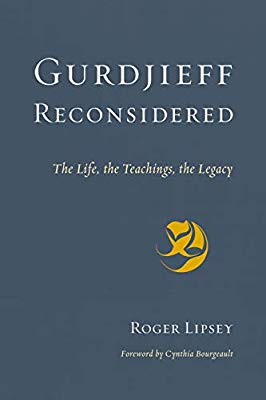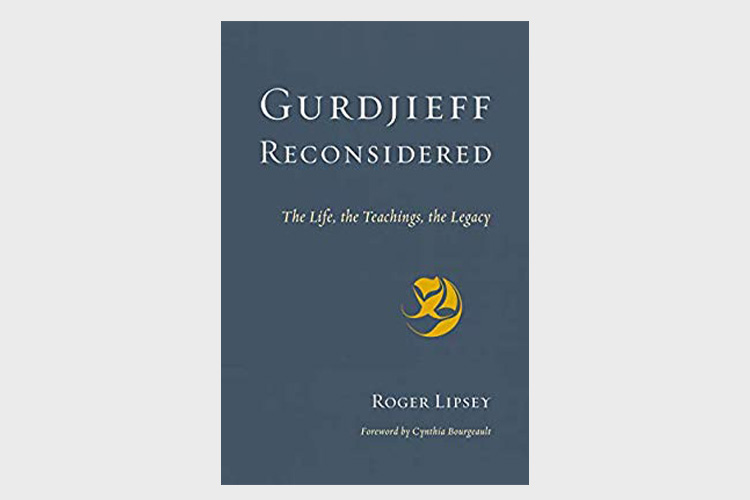
GURDJIEFF RECONSIDERED: The Life, the Teachings, The Legacy
Roger Lipsey. Foreword by Cynthia Bourgeault. Shambhala Publications (www.shambhala.com), 2019. PP. 384. $24.95 Paper
Reviewed by Jeff Zaleski
The thousands of books, magazines, and films about G.I. Gurdjieff (1866-1949) and his work mark him as an essential spiritual teacher. After this outpouring, is there anything new to say about Gurdjieff? And why might he need to be “reconsidered,” as Roger Lipsey (Dag Hammarskjold, etc.) suggests in the title of his remarkable new book?
After an enthusiastic foreword by Episcopal priest and author Cynthia Bourgeault, Lipsey stakes his ground: Despite the proliferation of Gurdjieff foundations and societies around the globe, he writes, “Gurdjieff and the teaching that bears his name are now all but sealed off from both mainstream history and current concern.” So “why should one care about Gurdjieff?” he asks. “This book reconsiders that question as fully as possible…” And this reconsideration, Lipsey explains, will offer both a “refinement” of Gurdjieff’s reputation as well as “a radical break from received opinion.”
Lipsey refines Gurdjieff’s reputation through a compelling amalgam of biography, exposition, and memoir. His emphasis is on Gurdjieff as an embodiment of what he taught (just as many today view the Dalai Lama as an embodiment of Tibetan Buddhism), a view informed by Lipsey’s nearly lifelong involvement with “the Work,” as the Gurdjieff teaching is called by adherents. To give readers some point of comparison to Gurdjieff, Lipsey puts forth Pythagoras, Diogenes, and Rabelais as predecessors. Pythagoras in particular resonates as a “philosopher, mathematician and geometer, cosmologist, music theorist,” etc.—pursuits that could be applied equally to Gurdjieff, who, like the ancient Greek, presented a wisdom teaching. But there is a deeper similarity. Pythagoras’ pupils, Lipsey tells us, “were known to say that there are men and women and a ‘third thing’”—by which these pupils meant their teacher, whom some considered a “child of the gods.” As evidenced throughout this book, Gurdjieff elicited a comparable response from most of his students, nearly universal in agreeing that the man was unlike any other they’d encountered and was fundamentally “unknowable.”
These comparisons testify not only to the mythic stature of Lipsey’s subject but also to the author’s freshness of approach. In the same innovative vein, Lipsey suggests a “mnemonic” to help get a handle on Gurdjieff’s epic and outwardly chaotic life: “Russia, theory; Prieuré, practice; 1930s, loss; 1940s, fulfillment.”
Lipsey’s inviting narration is buttressed by rigorous scholarship as he roams through not only the voluminous public record about Gurdjieff but, importantly, also through unpublished archives. In Lipsey’s mnemonic, the first period, “Russia,” refers mostly to the 1910s, after Gurdieff’s early years spent as a “seeker of truth.” Gurdjieff began teaching publicly in Moscow, in 1912; this and the years just following comprise the period most familiar to many, by way of In Search of the Miraculous, the classic account of study with Gurdjieff by the Russian philosopher P.D. Ouspensky.
The second phrase in the mnemonic, “Prieuré, practice,” refers to the expansive home outside Paris of Gurdjieff’s Institute for the Harmonious Development of Man, which drew to him some of his most worthy followers (A.R. Orage, Maurice Nicoll, et al.), but also unwelcome notoriety as the press, invited to observe goings on, generally mocked or sensationalized his teaching (“weird cult”). Public opinion degraded further after the death from tuberculosis at the Prieuré of the well-known writer Katherine Mansfield. Here, in a “radical break from received opinion,” Lipsey argues forcefully, with plenty of anecdotal evidence, that Mansfield found peace and meaning under Gurdjieff’s care; but, voiced most strongly by her husband, an outcry at her death arose that reverberated for decades.
Lipsey’s presentation of the last two phases of Gurdjieff’s life will prove revelatory to even those steeped in the literature. “1930s, loss” was a difficult time for Gurdjieff, beset by health and financial challenges, no longer living in the grand Prieuré, which closed in 1932 due to lack of funds, but now in a small apartment in Paris. With an admirable allegiance to truth, Lipsey acknowledges that Gurdjieff now turned to alcohol, sometimes to the point of apparent drunkenness. (“In mornings with such troubles as now,” he was overheard to say, “I make nervous, make elephant from fly. But with this Armagnac fly is not elephant. Fly is—fly.”) Yet at this same time, Gurdjieff’s teaching continued with vigor, most notably as he collected around him a group of distinguished female students, most lesbians, among them Margaret Anderson, Solita Solano, and Kathryn Hulme. Much of what we know about Gurdjieff at this time comes from their records, and one saying that has survived from then is, to paraphrase, “roses outside, thorns inside; thorns outside, roses inside”—a neat formulation of the role of suffering in spiritual work.
From the outward thorns of the 1930s, Lipsey explains, came the inward roses of the 1940s—a period of tremendous creativity for the aging Gurdjieff as he taught groups behind blackout curtains during the Nazi occupation, and after the war met and dined ritually with hundreds of students, French, English, and American, even as he produced new “Movements”—his sacred dances—at a ferocious pace.
Lipsey casts this period as “fulfillment.” Now Gurdjieff was no longer “the riding master of the Prieuré, nor the troubled genius of the 1930s,” but a being who radiated compassion, wisdom, and an inimitable ability to puncture his students’ pretentions. Here, Lipsey describes to readers his own invaluable, personal impressions of the tiny apartment where Gurdjieff lived and worked (and which the author visited in recent times), but he also allows others to provide potent commentary, most happily through his own translation of portions of a memoir new to English by one Francois Grunvald that vivifies what it was like to be in Gurdjieff’s presence:
He was sitting perfectly upright; an irresistible calm emanated from him. A silence progressively made itself felt, becoming more and more dense; a majestic grandeur confined by no material or psychological limit circulated in the space, inner as much as outer, and established itself in us. One’s attention became keener as all sensation of time disappeared. Each one of us, better and better established in himself, herself, was looking at him.
Today I am convinced that what we clearly experienced as an inner majesty did not emanate from his person as such, rather that he was a channel, a way of access to a “higher” which, without the least doubt, he rendered perceptible. His presence was the necessary transformer, permitting the plunge into a vastness, an immensity in which my own thoughts no longer importuned me as they ordinarily do, but withdrew. He offered passage to that inner grandeur, and that is why I venerate him.
Gurdjieff died on October 29, 1949. How did his followers and the world at large respond to his legacy? Lipsey approaches this question through the two chapters in his book most likely to stir debate. In the first, “The Great Prayer: 1950-1956,” he traces how Gurdjieff’s closest student, Jeanne de Salzmann, with him since 1919, organized many of his followers into the Gurdjieff Foundations that continue today, along with other groups, to pass on the teaching. Like all spiritual movements, the Gurdjieff Work has its varied lineages, with the inevitable agreements as well as disagreements. Lipsey focuses with approval and gratitude on the de Salzmann lineage, along with a respectful but questioning glance at John Bennett, the best known of Gurdjieff’s followers to break with de Salzmann to carve his own path. It’s a balanced and sensible presentation even if, in this increasingly sectarian world, not everyone will embrace Lipsey’s emphasis on the de Salzman legacy.
The chapter “Derision” may also generate debate. Here, Lipsey delineates the vigorous and nearly always insupportable attacks upon Gurdjieff made over the decades by a number of writers, most prominently the French journalist Louis Pauwels, who had studied briefly (and badly) with Gurdjieff in the 1940s, and who in 1954 published a damning critique of him (“Pauwels has many cruelties and stupidities in his book,” Lipsey charges)—so damning that he “drove the Gurdjieff teaching in Paris into hiding,” as Lipsey puts it (in this reviewer’s assessment, a tragedy that influenced other Gurdjieff groups towards anonymity, with profound consequences still in play). Pauwels is soon joined by a rogues’ gallery of other opinionators, among them psychiatrist Anthony Storr and, most sadly, Whitall Perry of the Traditionalists, a group whose teaching runs parallel to that of Gurdjieff’s but that sees him only as a spiritual renegade. Reading all this, one laments the need to provide any coverage of the falsehoods promoted by these men (all men), but given the savagery aimed at Gurdjieff it seems just and fitting that Lipsey demolishes their case so thoroughly.
This chapter also picks up a very hot potato, that of alleged sexual misconduct on Gurdjieff’s part. “If he could have a weakness,” wrote Solita Solano, “I’d say it was with women.” No one who knew him considered Gurdjieff to be a sexual predator, but without question he thought sex important and was willing to sleep with—and to generate children with—some of his followers.
“There is something to face here,” Lipsey states. He discerns that “two levels” operated in Gurdjieff: at one level, “Gurdjieff the incomparable teacher of Being”; at the other, “Gurdjieff the man with sexual needs like other men.” His conclusion: “But consider: Do we need to forgive Gurdjieff? I think so”—a compassionate suggestion that some nonetheless will find unnecessary and others insufficient. This is inevitable, yet Lipsey is to be commended for addressing a subject that few who have loved Gurdjieff and his teaching have been willing to discuss.
An evaluation of Gurdjieff’s literary magnus opus, Beelzebub’s Tales to His Grandson, as well as two brief chapters that include an appreciation for Lipsey’s teachers within the Gurdjieff Work, conclude the book.
What finally is the Gurdjieff Work? Perhaps calling it a “work for being” comes closest, and in this dynamic book, a triumph of engaged scholarship and a necessary read for anyone interested in Gurdjieff and his teaching, Lipsey paints a memorable portrait of a man of great being. But to what end is this “work for being?” Here, translated by Lipsey from the French, from an unpublished document in a private archive, is a “vow or prayer” given by Gurdjieff to his French pupils in the 1940s:
I wish to be, I can be, I have a right to be. I have the ability to be. I swear to myself that this will never be for my personal profit, but to help others. I wish to be, to help others. This is to be understood as a vow.
From Parabola Volume 44, No. 2, “The Wild,” Summer 2019. This issue is available to purchase here. If you have enjoyed this piece, consider subscribing. Four times a year Parabola has explored the deepest questions of human existence. Without your support, we would cease to exist. Please consider helping us by making a donation.
